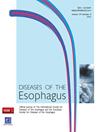260. LOW BLOOD LEVEL OF TUMOR SUPPRESSOR MIR-3619 AS A TARGET OF NUCLEIC ACID THERAPY TO PIM-1 IN ESOPHAGEAL CANCER
IF 2.3
3区 医学
Q3 GASTROENTEROLOGY & HEPATOLOGY
引用次数: 0
Abstract
Background Numerous studies have attempted to understand the molecular mechanisms of tumorigenesis and identify clinical biomarkers and molecular targets for esophageal squamous cell carcinoma (ESCC). However, there are still only a few biomarkers and targets. We focused on tumor suppressor micro-RNA (miR)s in the plasma of ESCC patients, and we investigated the usefulness of these tumor suppressor miRs as biomarkers and therapeutic agents for ESCC. Methods: Plasma samples of 94 ESCC patients and 86 healthy volunteers were analyzed in this study. Among the group of 2600 miRs candidates registered in miRbase, we selected 25 miRs candidates which are low expressed in ESCC tissues, have tumor suppressive functions, and unreported as a body fluid biomarker. We selected 5 miRs (miR-564/ 637/ 1182/ 3178/ 3619), whose signals were detectable in the blood of healthy volunteers by microarray analysis. By test-scale analysis using TaqMan assay and validation analysis, we identified miR-3619, which showed the most significant difference in ESCC patients compared to healthy volunteers (p < 0.001). Results: 1) Prognostic analysis revealed that a low miR-3619 plasma level was significantly associated with advanced stage and recurrence rate, and was an independent factor predicting poor prognosis in ESCC patients (p = 0.028, HR = 2.09). 2) Overexpression of miR-3619 mimic inhibited the proliferation of ESCC cells, induced the accumulation of apoptosis or G1/S phase cells, and reduced the cell migration and invasion abilities compared with negative control mimic. 3) We tested PIM-1xas candidate putative target genes for miR-3619 using microRNA database. PIM-1 protein expression levels were decreased in miR-3619-5p transfectants compared with NC. 4) In vivo, subcutaneous injection of miR-3619 could significantly inhibit tumor growth in mice. Administration of miR-3619 did not cause any clinical adverse events or side effects in blood-based parameters reflecting organ disorders. Conclusion: These results suggest that depleted tumor-suppressor miR-3619 in plasma could be one of blood-based biomarkers for predicting malignant potential of ESCC.260.低血药浓度的肿瘤抑制因子 mir-3619 作为食管癌 pim-1 核酸疗法的靶点
背景 众多研究试图了解肿瘤发生的分子机制,并确定食管鳞状细胞癌(ESCC)的临床生物标志物和分子靶点。然而,目前仍只有少数生物标志物和靶点。我们重点研究了 ESCC 患者血浆中的肿瘤抑制性微 RNA (miR),并探讨了这些肿瘤抑制性 miR 作为 ESCC 生物标志物和治疗药物的作用。研究方法本研究分析了 94 名 ESCC 患者和 86 名健康志愿者的血浆样本。在 miRbase 中登记的 2600 个候选 miRs 中,我们选择了 25 个候选 miRs,它们在 ESCC 组织中低表达,具有肿瘤抑制功能,且未被报道为体液生物标志物。我们选择了 5 个 miRs(miR-564/ 637/ 1182/ 3178/ 3619),这些 miRs 在健康志愿者的血液中通过芯片分析可检测到信号。通过使用 TaqMan 分析法进行测试规模分析和验证分析,我们确定了 miR-3619,与健康志愿者相比,它在 ESCC 患者中显示出最显著的差异(p &p;lt;0.001)。结果1)预后分析表明,miR-3619 血浆水平低与晚期和复发率显著相关,是预测 ESCC 患者预后不良的独立因素(p = 0.028,HR = 2.09)。2)与阴性对照模拟物相比,过表达 miR-3619 可抑制 ESCC 细胞的增殖,诱导细胞凋亡或 G1/S 期细胞的积累,并降低细胞的迁移和侵袭能力。3) 我们利用 microRNA 数据库检测了 PIM-1x 作为 miR-3619 的候选靶基因。与 NC 相比,miR-3619-5p 转染者的 PIM-1 蛋白表达水平降低。4) 在体内,皮下注射 miR-3619 能显著抑制小鼠肿瘤的生长。注射 miR-3619 不会引起任何临床不良反应,也不会对反映器官功能紊乱的血液指标产生副作用。结论这些结果表明,血浆中耗竭的肿瘤抑制因子miR-3619可作为预测ESCC恶性潜能的血液生物标志物之一。
本文章由计算机程序翻译,如有差异,请以英文原文为准。
求助全文
约1分钟内获得全文
求助全文
来源期刊

Diseases of the Esophagus
医学-胃肠肝病学
CiteScore
5.30
自引率
7.70%
发文量
568
审稿时长
6 months
期刊介绍:
Diseases of the Esophagus covers all aspects of the esophagus - etiology, investigation and diagnosis, and both medical and surgical treatment.
 求助内容:
求助内容: 应助结果提醒方式:
应助结果提醒方式:


